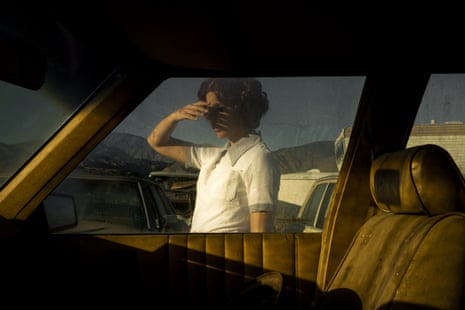
Afew years ago, my boyfriend and I took a trip to Joshua Tree national park in southern California. We stopped for a bathroom break at a gas station in a small town and bumped into a crazy guy. Talking to him opened our eyes: we realised there were so many of these places littered along the highway, sort of like nowhere lands. It seemed like they were worth exploring.
This shot was taken in 2017 in one of those small towns in the California desert. It’s in the middle of nowhere, but something about it resonated with me. People live there in order not to be found. They don’t really want to interact with outsiders.
On one trip there, I found a house with loads of cars parked outside, almost as if they were abandoned. I’m a nervous person and I find talking to strangers quite difficult, especially in a place like this, so I didn’t ask for permission to take photographs. I had to hide myself between the cars and set up my equipment almost in secret.
This shot is a self-portrait but it doesn’t really have a story in a traditional sense, I’m more interested in the emotion of an image. I don’t plan a shot, I just search for a feeling. Here, I think it’s a sense of nostalgia. As humans we’re drawn to it – even nostalgia for the very recent past. There’s always this belief that the past was better in some way.
People often think I have these big, crazy productions behind my work. But it’s usually just me, alone, improvising with things or scenes that I find. Because I shoot self-portraits, I don’t need much else. There’s an independence to being alone.
My work is cinematic in some senses, but I don’t do self-portraits in a Cindy Sherman kind of way. In fact self-portraiture was actually pretty accidental. In my early work I would approach strangers, or ask to shoot family friends, but it was just so full-on. I found it really stressful.
I was going through a lot of changes in my personal life and it became difficult to work because I found it so difficult to talk to other people. Self-portraiture was a practical way of dealing with that anxiety, and over time it became therapeutic. If you take a photo of somebody they always have an idea of how they want to be portrayed, and I think on some level you get sucked into, or play along with, their conceptions of what you are doing. I’m extremely conscious of taking up too much of people’s time, or of making them uncomfortable. So I found it really liberating to have no expectations, to be able to make the work that I wanted to make and step away from the demands or desires of others.
Although it’s me in my work, I don’t see myself in it at all. I’m completely detached. The people in the images are characters. There’s nothing biographical in them, nothing of my identity. I see myself as a tool for the work. Self-portraits aren’t a way for me to work out things about myself – if anything they are a way of hiding myself.
That anonymity allows people to project their own ideas on to the work. They construct amazing stories from these images, and will ask me where the woman is going, who she is, where she’s from. I don’t really feel like I know any better than them.
This shot is part of a series called Proceed to the Route. I was driving through the desert when my internet suddenly cut out. But the voice on the navigation software just kept on with this refrain: proceed to the route, proceed to the route. It felt like we can’t even get lost any more! Everything is preplanned and predetermined. It seemed a metaphor for a lot of life and the level of expectation we live with: you’re supposed to go to high school, then to college, then get a house. There are all these steps on the ladder of success, and there’s almost no room for detours and deviations.
This image is about those detours – the moment of being lost, needing to get somewhere but being paralysed and unable to do anything about it.
Tania Franco Klein’s CV
Born: Mexico City, 1990.
Studied: Architecture at the Centro design school in Mexico and fashion photography at University of the Arts, London.
Influences: Larry Sultan, William Eggleston, Jimmy De Sana, Stephen Shore, Guy Bourdin.
High point: “Exhibiting and working with Santa Monica’s ROSEGALLERY. And designing and publishing my first monograph Positive Disintegration.”
Low point: “It took me a while to understand how my work could fit into both the commercial industry and the art world. I think nobody really teaches you what to do with your work. The uncertainty at the beginning was definitely a challenging period. That being said, I wouldn’t change that part of my career because I learned a lot from it.”
Top tip: “Don’t compromise your style and your interests to fit into whatever is trendy in the industry at the moment. Concentrate on whatever is important for you and be persistent and truthful to yourself. Passion is contagious.”

